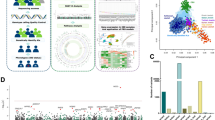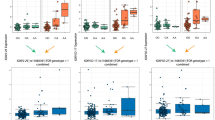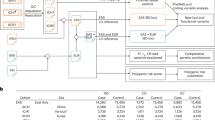Abstract
Inflammatory bowel disease (IBD) is a chronic disorder caused by multiple factors in a genetically susceptible host. Significant advances in the study of genetic susceptibility have highlighted the importance of the innate immune system in this disease. We previously completed a genome-wide linkage study and found a significant locus (IBD6) on chromosome 19p. We were interested in identifying the causal variant in IBD6. We performed a two-stage association mapping study. In stage 1, 1530 single-nucleotide polymorphisms (SNPs) were selected from the HapMap database and genotyped in 761 patients with IBD. Among the SNPs that passed the threshold for replication, 26 were successfully genotyped in 754 additional patients (stage 2). One intronic variant, rs273506, located in the microtubule-associated serine/threonine-protein kinase gene-3 (MAST3), was found to be associated in both stages (pooled P=1.8 × 10−4). We identified four MAST3 coding variants, including a non-synonymous SNP rs8108738, correlated to rs273506 and associated with IBD. To test whether MAST3 was expressed in cells of interest, we performed expression assays, which showed abundant expression of MAST3 in antigen-presenting cells and in lymphocytes. The knockdown of MAST3 specifically decreased Toll-like receptor-4-dependent NF-κB activity. Our findings are additional proofs of the pivotal role played by modulators of NF-κB activity in IBD pathogenesis.
This is a preview of subscription content, access via your institution
Access options
Subscribe to this journal
Receive 6 digital issues and online access to articles
$119.00 per year
only $19.83 per issue
Buy this article
- Purchase on Springer Link
- Instant access to full article PDF
Prices may be subject to local taxes which are calculated during checkout





Similar content being viewed by others
References
Kappelman MD, Rifas-Shiman SL, Kleinman K, Ollendorf D, Bousvaros A, Grand RJ et al. The prevalence and geographic distribution of Crohn's disease and ulcerative colitis in the United States. Clin Gastroenterol Hepatol 2007; 5: 1424–1429.
Baumgart DC, Carding SR . Inflammatory bowel disease: cause and immunobiology. Lancet 2007; 369: 1627–1640.
Hugot JP, Chamaillard M, Zouali H, Lesage S, Cezard JP, Belaiche J et al. Association of NOD2 leucine-rich repeat variants with susceptibility to Crohn's disease. Nature 2001; 411: 599–603.
Ogura Y, Bonen DK, Inohara N, Nicolae DL, Chen FF, Ramos R et al. A frameshift mutation in NOD2 associated with susceptibility to Crohn's disease. Nature 2001; 411: 603–606.
Rioux JD, Daly MJ, Silverberg MS, Lindblad K, Steinhart H, Cohen Z et al. Genetic variation in the 5q31 cytokine gene cluster confers susceptibility to Crohn disease. Nat Genet 2001; 29: 223–228.
Duerr RH, Taylor KD, Brant SR, Rioux JD, Silverberg MS, Daly MJ et al. A genome-wide association study identifies IL23R as an inflammatory bowel disease gene. Science 2006; 314: 1461–1463.
Franke A, Hampe J, Rosenstiel P, Becker C, Wagner F, Hasler R et al. Systematic association mapping identifies NELL1 as a novel IBD disease gene. PLoS ONE 2007; 2: e691.
Hampe J, Franke A, Rosenstiel P, Till A, Teuber M, Huse K et al. A genome-wide association scan of nonsynonymous SNPs identifies a susceptibility variant for Crohn disease in ATG16L1. Nat Genet 2007; 39: 207–211.
Libioulle C, Louis E, Hansoul S, Sandor C, Farnir F, Franchimont D et al. Novel Crohn disease locus identified by genome-wide association maps to a gene desert on 5p13.1 and modulates expression of PTGER4. PLoS Genet 2007; 3: e58.
Parkes M, Barrett JC, Prescott NJ, Tremelling M, Anderson CA, Fisher SA et al. Sequence variants in the autophagy gene IRGM and multiple other replicating loci contribute to Crohn's disease susceptibility. Nat Genet 2007; 39: 830–832.
Rioux JD, Xavier RJ, Taylor KD, Silverberg MS, Goyette P, Huett A et al. Genome-wide association study identifies new susceptibility loci for Crohn disease and implicates autophagy in disease pathogenesis. Nat Genet 2007; 39: 596–604.
WTCCC. Genome-wide association study of 14 000 cases of seven common diseases and 3000 shared controls. Nature 2007; 447: 661–678.
Rioux JD, Silverberg MS, Daly MJ, Steinhart AH, McLeod RS, Griffiths AM et al. Genomewide search in Canadian families with inflammatory bowel disease reveals two novel susceptibility loci. Am J Hum Genet 2000; 66: 1863–1870.
Cho JH, Nicolae DL, Gold LH, Fields CT, LaBuda MC, Rohal PM et al. Identification of novel susceptibility loci for inflammatory bowel disease on chromosomes 1p, 3q, and 4q: evidence for epistasis between 1p and IBD1. Proc Natl Acad Sci USA 1998; 95: 7502–7507.
Ma Y, Ohmen JD, Li Z, Bentley LG, McElree C, Pressman S et al. A genome-wide search identifies potential new susceptibility loci for Crohn's disease. Inflamm Bowel Dis 1999; 5: 271–278.
Grimwood J, Gordon LA, Olsen A, Terry A, Schmutz J, Lamerdin J et al. The DNA sequence and biology of human chromosome 19. Nature 2004; 428: 529–535.
Tello-Ruiz MK, Curley C, DelMonte T, Giallourakis C, Kirby A, Miller K et al. Haplotype-based association analysis of 56 functional candidate genes in the IBD6 locus on chromosome 19. Eur J Hum Genet 2006; 14: 780–790.
van Bodegraven AA, Curley CR, Hunt KA, Monsuur AJ, Linskens RK, Onnie CM et al. Genetic variation in myosin IXB is associated with ulcerative colitis. Gastroenterology 2006; 131: 1768–1774.
Steinman L . A brief history of T(H)17, the first major revision in the T(H)1/T(H)2 hypothesis of T cell-mediated tissue damage. Nat Med 2007; 13: 139–145.
NCBI. HomoloGene 2008. http://www.ncbi.nlm.nih.gov/sites/entrez?db=homologene In.
Valiente M, Andres-Pons A, Gomar B, Torres J, Gil A, Tapparel C et al. Binding of PTEN to specific PDZ domains contributes to PTEN protein stability and phosphorylation by microtubule-associated serine/threonine kinases. J Biol Chem 2005; 280: 28936–28943.
Lumeng C, Phelps S, Crawford GE, Walden PD, Barald K, Chamberlain JS . Interactions between beta 2-syntrophin and a family of microtubule-associated serine/threonine kinases. Nat Neurosci 1999; 2: 611–617.
Sun L, Gu S, Li X, Sun Y, Zheng D, Yu K et al. [Identification of a novel human MAST4 gene, a new member of the microtubule associated serine-threonine kinase family]. Mol Biol (Mosk) 2006; 40: 808–815.
Walden PD, Cowan NJ . A novel 205-kilodalton testis-specific serine/threonine protein kinase associated with microtubules of the spermatid manchette. Mol Cell Biol 1993; 13: 7625–7635.
Xiong H, Li H, Chen Y, Zhao J, Unkeless JC . Interaction of TRAF6 with MAST205 regulates NF-kappaB activation and MAST205 stability. J Biol Chem 2004; 279: 43675–43683.
Zhou H, Xiong H, Li H, Plevy SE, Walden PD, Sassaroli M et al. Microtubule-associated serine/threonine kinase-205 kDa and Fc gamma receptor control IL-12 p40 synthesis and NF-kappa B activation. J Immunol 2004; 172: 2559–2568.
Barrett JC, Hansoul S, Nicolae DL, Cho JH, Duerr RH, Rioux JD et al. Genome-wide association defines more than thirty distinct susceptibility loci for Crohn's disease. Nat Genet 2008 (in press). Published online: 29 June 2008; doi:10.1038/ng.175.
Dixon AL, Liang L, Moffatt MF, Chen W, Heath S, Wong KC et al. A genome-wide association study of global gene expression. Nat Genet 2007; 39: 1202–1207.
Su AI, Cooke MP, Ching KA, Hakak Y, Walker JR, Wiltshire T et al. Large-scale analysis of the human and mouse transcriptomes. Proc Natl Acad Sci USA 2002; 99: 4465–4470.
McGovern D, Powrie F . The IL23 axis plays a key role in the pathogenesis of IBD. Gut 2007; 56: 1333–1336.
Gay NJ, Gangloff M . Structure and function of Toll receptors and their ligands. Annu Rev Biochem 2007; 76: 141–165.
De Jager PL, Franchimont D, Waliszewska A, Bitton A, Cohen A, Langelier D et al. The role of the Toll receptor pathway in susceptibility to inflammatory bowel diseases. Genes Immun 2007; 8: 387–397.
Arbour NC, Lorenz E, Schutte BC, Zabner J, Kline JN, Jones M et al. TLR4 mutations are associated with endotoxin hyporesponsiveness in humans. Nat Genet 2000; 25: 187–191.
Shen R, Fan JB, Campbell D, Chang W, Chen J, Doucet D et al. High-throughput SNP genotyping on universal bead arrays. Mutat Res 2005; 573: 70–82.
Spielman RS, McGinnis RE, Ewens WJ . Transmission test for linkage disequilibrium: the insulin gene region and insulin-dependent diabetes mellitus (IDDM). Am J Hum Genet 1993; 52: 506–516.
Acknowledgements
This project was funded by grants from the National Institute of Diabetes and Digestive and Kidney Diseases DK062432 to JDR and AI062773 to RJX. The Broad Institute Center for Genotyping and Analysis is supported by Grant U54 RR020278 from the National Center for Research Resources. C Labbé is the recipient of a Fond de Recherche en Santé du Québec studentship award. We thank Marcia Budarf, Marie-Pierre Lévesque and Jing Lian for their help in the review of the paper.
Author information
Authors and Affiliations
Corresponding author
Additional information
Competing interests
The authors have declared that no competing interest exists.
Supplementary Information accompanies the paper on Genes and Immunity website (http://www.nature.com/gene)
Rights and permissions
About this article
Cite this article
Labbé, C., Goyette, P., Lefebvre, C. et al. MAST3: a novel IBD risk factor that modulates TLR4 signaling. Genes Immun 9, 602–612 (2008). https://doi.org/10.1038/gene.2008.57
Received:
Revised:
Accepted:
Published:
Issue Date:
DOI: https://doi.org/10.1038/gene.2008.57
Keywords
This article is cited by
-
Kernel-based genetic association analysis for microbiome phenotypes identifies host genetic drivers of beta-diversity
Microbiome (2023)
-
Altered expression of Tumor Necrosis Factor Alpha -Induced Protein 3 correlates with disease severity in Ulcerative Colitis
Scientific Reports (2017)
-
MAST-like protein kinase IREH1 from Arabidopsis thaliana co-localizes with the centrosome when expressed in animal cells
Planta (2017)
-
The nuts and bolts of AGC protein kinases
Nature Reviews Molecular Cell Biology (2010)



